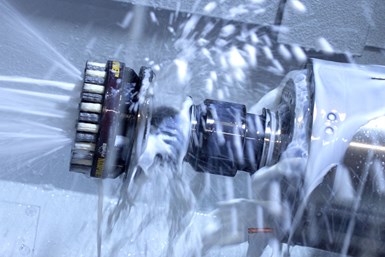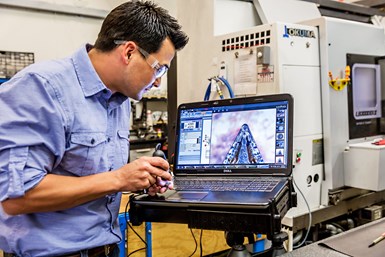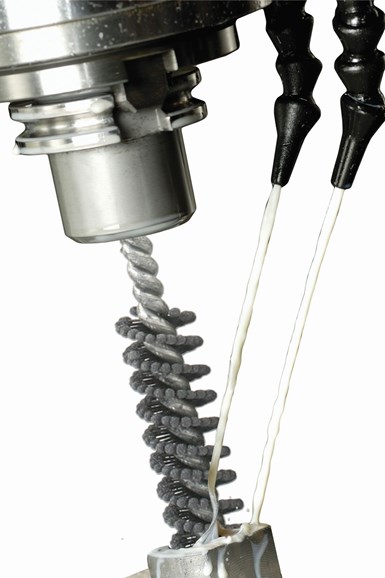The Case for Abrasive Finishing Tools in CNC Applications
According to Brush Research Manufacturing, abrasive finishing tools do not release large amounts of grit into a machine’s coolant. Hear from three shops using these tools.
Share





With advances in abrasive technology, machining center operators can complete surface finishing simultaneously with other machining operations to speed cycle times, improve quality and save on offline finishing time and costs. As a result, contract machine shops are increasingly turning to abrasive finishing tools that can be integrated easily into CNC machine carousels or toolholding systems. However, in doing so, questions can arise about the use of abrasive materials in expensive CNC machining centers. The concern is often a generalized impression that these abrasives act like sandpaper and release large amounts of grit and debris that could potentially clog coolant lines or damage exposed slides or bearings.

Machinist Eric Sun says the NamPower brush from Brush Research Manufacturing is a “different type of abrasive.” He reports that he has had no issues with particulate or grit getting onto critical surfaces.
“These are very expensive, very accurate machines,” says Janos Garaczi, president of Delta Machine Co. LLC, a machine shop located in Gardena, California, that specializes in complex, tight-tolerance parts made of titanium, nickel alloys, stainless steel, aluminum, plastics and other exotic alloys. “I wouldn’t do anything to jeopardize the accuracy or lifespan of the equipment.”
Abrasive Distinctions
A closer examination of abrasive tools demonstrates that these concerns are largely unfounded. Although abrasives are often lumped into the same category, a distinction must be made between abrasives used for aggressive material removal and abrasive finishing tools. According to Brush Research Manufacturing, which is based in Los Angeles, finishing tools release little to no abrasive grit during use, and the amount generated is comparable to the metal chips, grinding dust and tool abrasion created during the machining process itself.
“These are very expensive, very accurate machines. I wouldn’t do anything to jeopardize the accuracy or lifespan of the equipment.”
Even if minimal fine solids are produced, the filtration requirements for abrasive tools are not much different than those for machining. Any particulate can be easily removed using inexpensive bag or cartridge filtration systems, says Jeff Brooks of Filtra Systems, a company specializing in industrial filtration systems, including those for CNC coolant.
“A disposable media vacuum filter or pressure filter is the most cost-effective option for the end user for filtration that will achieve the high clarity levels required,” Mr. Brooks says.
“For fine honing work, I would recommend a 20-micron bag or cartridge filter, at minimum, to catch any fine solids and adequately protect the tool, the sump pump and keep the coolant ports from clogging,” says Chris Erato, director of sales at Oberlin Filter, a manufacturer of separation filtration for CNC coolant systems.
Stories from the Shop Floor
According to Tim Urano, quality manager at Wolfram Manufacturing, based in Austin, Texas, any additional cost for filtration related to the use of abrasive tools is negligible because filtration systems are already required to remove particulate from the coolant generated during the machining process itself.

When using abrasive tools, Tim Urano of Wolfram Manufacturing says he has never experienced any problems caused by abrasives in the cutting fluids.
At his shop, that includes scale, grit and rust created by cutting through raw stock. Wolfram Manufacturing is also machining 3D parts made of Inconel, which can release fine metal powder into the coolant that isn’t fully sintered. As for abrasive tools, Mr. Urano says that Wolfram Manufacturing has never experienced any problems caused by abrasives in its cutting fluids.
For the past eight years, the machine shop has incorporated the Flex-Hone from Brush Research Manufacturing in all of its CNC machines used for cross-hole deburring and surface finishing. Characterized by the small, abrasive globules that are permanently mounted to flexible filaments, the product is a flexible, low-cost tool used for surfacing, deburring and edge-blending.
Removal of burrs and sharp edges in cross-drilled holes and other difficult-to-access areas such as undercuts, grooves, slots and internal holes is critical because they can cause blockages or create turbulence in the flow of fluids, lubricants and gases through critical passages.

According to Brush Research Manufacturing, the impact of abrasive tools is negligible because filtration systems are already required to remove particulate from the coolant generated during the machining process itself.
“On a given part, we might deploy two to three different size Flex-Hones, depending on the number of cross-port intersections and different hole sizes,” Mr. Urano says.
The Flex-Hones are added to the tool carousel and are used daily, usually several times an hour, on some of the shop’s highest-volume parts.
“The volume of abrasives that could even possibly come off of the Flex-Hone is insignificant compared to the rest of the particulate that gets into the coolant,” Mr. Urano says.
At Delta Machine, automated crosshole deburring is also integrated into the CNC machining process.
“When you use the Flex-Hone for deburring, all you are doing is removing the burr. It doesn’t create much dust,” Mr. Garaczi says. “So, for me, any grit or dust released is zero concern. It is not like we are grinding inside the machine with powder everywhere — this is not the same at all.”
Abrasive Nylon Filaments
For Eric Sun, founder of Orange Vise Co. LLC in Orange County, California, even cutting tools such as carbide drills and end mills can create debris that must be filtered from the coolant.
“Some machine shops might say, ‘I don’t use any abrasives in my process; therefore, my machine is completely free of all particulate matter,’ but that is not the case. Even cutting tools can wear down and the carbide can come loose and get into the coolant,” Mr. Sun says.
Although Orange Vise is a contract manufacturer, the company primarily machines vises and quick-change fixturing components out of aluminum, steel and cast iron. The company uses four Mori Seiki NHX4000 high-speed horizontal machining centers and two vertical machining centers.
According to Mr. Sun, many of the vises are made of cast iron with selectively hardened surfaces. To match the surface finish of the hardened surfaces, Orange Vise uses Brush Research Manufacturing’s NamPower abrasive disc brushes.
Composed of flexible abrasive nylon filaments bonded to a fiber-reinforced thermoplastic base, the NamPower abrasive disc brushes contain a unique combination of both ceramic and silicon carbide abrasive. The abrasive filaments work like flexible files, conforming to part contours, wiping and filing across part edges and surfaces to deliver maximum burr removal rates along with an ideal surface finish. Other common uses are edge blending, part cleaning and rust removal.
To complete the surface finishing operation, abrasive nylon brushes are installed in the tool loading system of each CNC machine. Although abrasive grit is involved, Mr. Sun says the NamPower brush is a different type of abrasive because it is essentially self-sharpening. Because of its linear construction, sharp new grains constantly come in contact with the work surface and wear off, exposing fresh cutting particles.
“We have used the NamPower abrasive nylon brushes daily for six years. During that time, we have had no issues with any sort of particulate or grit getting onto any critical surfaces,” Mr. Sun adds. “In our experience, any small amount of grit created is a non-issue.”
Related Content
Toolpath Improves Chip Management for Swiss-Type Lathes
This simple change to a Swiss-type turning machine’s toolpath can dramatically improve its ability to manage chips.
Read MoreHow to Accelerate Robotic Deburring & Automated Material Removal
Pairing automation with air-driven motors that push cutting tool speeds up to 65,000 RPM with no duty cycle can dramatically improve throughput and improve finishing.
Read MoreSelecting a Thread Mill That Matches Your Needs
Threading tools with the flexibility to thread a broad variety of holes provide the agility many shops need to stay competitive. They may be the only solution for many difficult materials.
Read MoreLean Approach to Automated Machine Tending Delivers Quicker Paths to Success
Almost any shop can automate at least some of its production, even in low-volume, high-mix applications. The key to getting started is finding the simplest solutions that fit your requirements. It helps to work with an automation partner that understands your needs.
Read MoreRead Next
Brush Hone Boosts Safety, Productivity, Finish Quality
This manufacturer recently employed the Flex-Hone ball-style honing brush from Brush Research Manufacturing to automate the finishing of die bores. In addition to providing quality and productivity improvements, the tool helped eliminate the potential for operator discomfort and injury.
Read MoreSetting Up the Building Blocks for a Digital Factory
Woodward Inc. spent over a year developing an API to connect machines to its digital factory. Caron Engineering’s MiConnect has cut most of this process while also granting the shop greater access to machine information.
Read MoreRegistration Now Open for the Precision Machining Technology Show (PMTS) 2025
The precision machining industry’s premier event returns to Cleveland, OH, April 1-3.
Read More















.png;maxWidth=300;quality=90)














